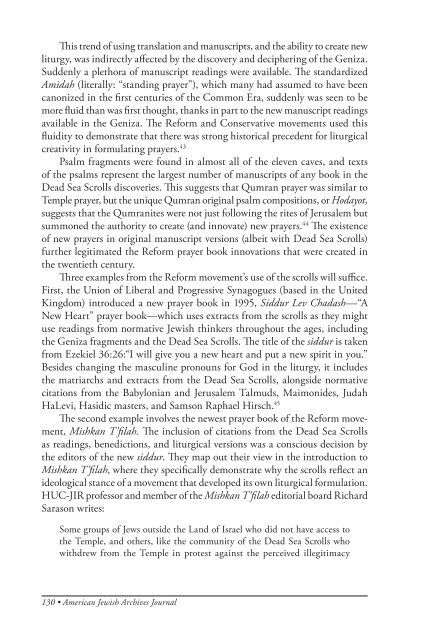The American Jewish Archives Journal, Volume LXI 2009, Number 1
The American Jewish Archives Journal, Volume LXI 2009, Number 1
The American Jewish Archives Journal, Volume LXI 2009, Number 1
You also want an ePaper? Increase the reach of your titles
YUMPU automatically turns print PDFs into web optimized ePapers that Google loves.
This trend of using translation and manuscripts, and the ability to create new<br />
liturgy, was indirectly affected by the discovery and deciphering of the Geniza.<br />
Suddenly a plethora of manuscript readings were available. <strong>The</strong> standardized<br />
Amidah (literally: “standing prayer”), which many had assumed to have been<br />
canonized in the first centuries of the Common Era, suddenly was seen to be<br />
more fluid than was first thought, thanks in part to the new manuscript readings<br />
available in the Geniza. <strong>The</strong> Reform and Conservative movements used this<br />
fluidity to demonstrate that there was strong historical precedent for liturgical<br />
creativity in formulating prayers. 43<br />
Psalm fragments were found in almost all of the eleven caves, and texts<br />
of the psalms represent the largest number of manuscripts of any book in the<br />
Dead Sea Scrolls discoveries. This suggests that Qumran prayer was similar to<br />
Temple prayer, but the unique Qumran original psalm compositions, or Hodayot,<br />
suggests that the Qumranites were not just following the rites of Jerusalem but<br />
summoned the authority to create (and innovate) new prayers. 44 <strong>The</strong> existence<br />
of new prayers in original manuscript versions (albeit with Dead Sea Scrolls)<br />
further legitimated the Reform prayer book innovations that were created in<br />
the twentieth century.<br />
Three examples from the Reform movement’s use of the scrolls will suffice.<br />
First, the Union of Liberal and Progressive Synagogues (based in the United<br />
Kingdom) introduced a new prayer book in 1995, Siddur Lev Chadash—“A<br />
New Heart” prayer book—which uses extracts from the scrolls as they might<br />
use readings from normative <strong>Jewish</strong> thinkers throughout the ages, including<br />
the Geniza fragments and the Dead Sea Scrolls. <strong>The</strong> title of the siddur is taken<br />
from Ezekiel 36:26:“I will give you a new heart and put a new spirit in you.”<br />
Besides changing the masculine pronouns for God in the liturgy, it includes<br />
the matriarchs and extracts from the Dead Sea Scrolls, alongside normative<br />
citations from the Babylonian and Jerusalem Talmuds, Maimonides, Judah<br />
HaLevi, Hasidic masters, and Samson Raphael Hirsch. 45<br />
<strong>The</strong> second example involves the newest prayer book of the Reform movement,<br />
Mishkan T’filah. <strong>The</strong> inclusion of citations from the Dead Sea Scrolls<br />
as readings, benedictions, and liturgical versions was a conscious decision by<br />
the editors of the new siddur. <strong>The</strong>y map out their view in the introduction to<br />
Mishkan T’filah, where they specifically demonstrate why the scrolls reflect an<br />
ideological stance of a movement that developed its own liturgical formulation.<br />
HUC-JIR professor and member of the Mishkan T’filah editorial board Richard<br />
Sarason writes:<br />
Some groups of Jews outside the Land of Israel who did not have access to<br />
the Temple, and others, like the community of the Dead Sea Scrolls who<br />
withdrew from the Temple in protest against the perceived illegitimacy<br />
130 • <strong>American</strong> <strong>Jewish</strong> <strong>Archives</strong> <strong>Journal</strong>

















